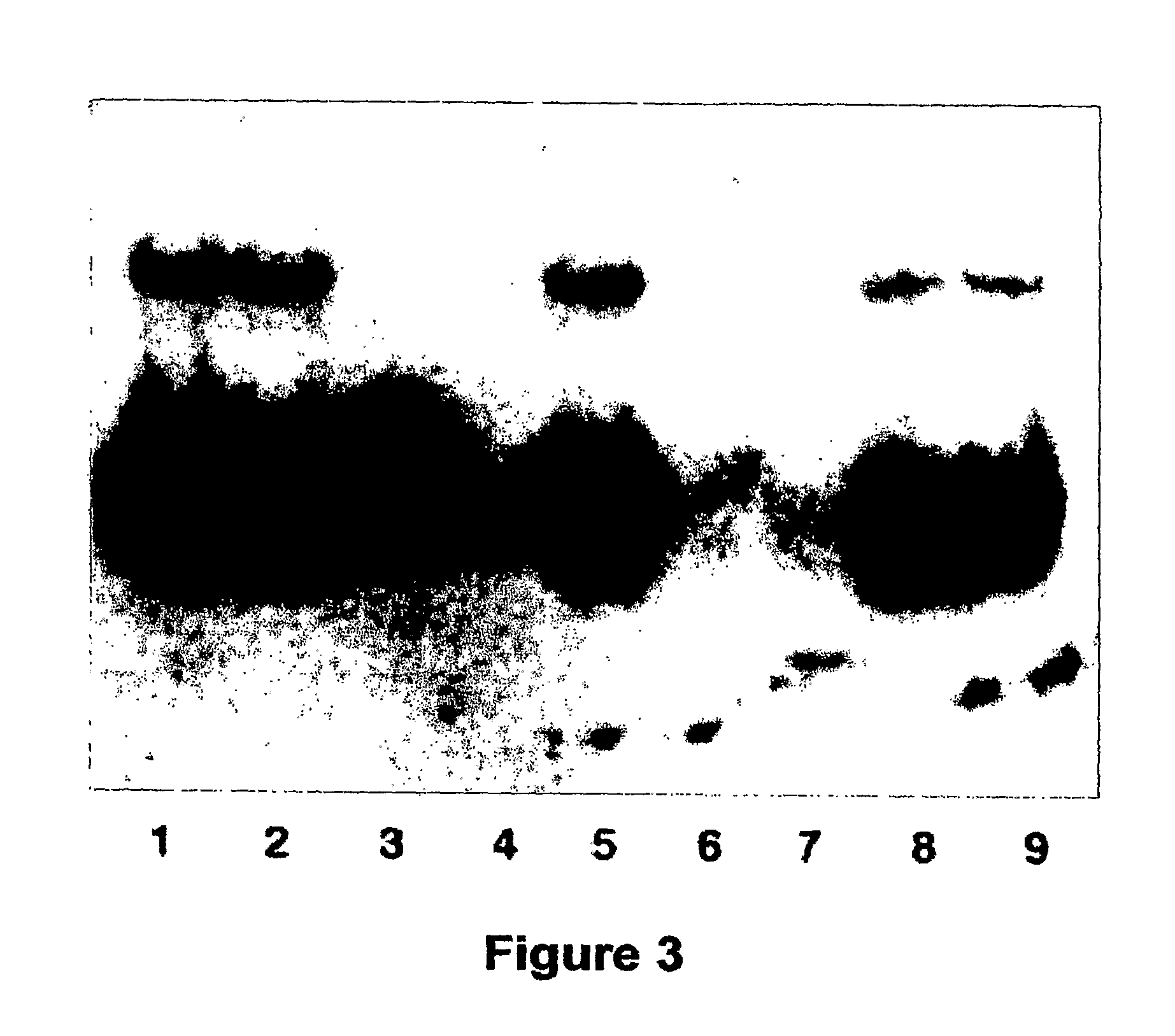Transgenic mouse model of B cell malignancy
a mouse model and tumor technology, applied in the field of tumor tumor tumor tumor transgenic mouse model, can solve the problems of insufficient production of red cells, white cells and platelets, etc., and achieve the effect of reducing one or more symptoms and preventing or treating a lymphoproliferative condition
- Summary
- Abstract
- Description
- Claims
- Application Information
AI Technical Summary
Benefits of technology
Problems solved by technology
Method used
Image
Examples
example 1
Production of Eμ-mmu-miR155 Transgenic Mice
[0081]Materials and Methods
[0082]Transgenic Mice:
[0083]A 318-bp fragment containing the precursor sequence of miR155 was amplified by PCR from the genome of the 129SvJ mouse (The Jackson Laboratory) and cloned into the EcoRV and SalI sites of the pBSVE6BK (pEμ) plasmid, which contains the Eμ enhancer VH promoter for Ig heavy chains and the 3′ UTR and the poly(A) of the human β-globin gene (FIG. 1), and had been used previously for the development of chronic lymphocytic leukemia in Eμ-TCL1 transgenic mice (Bichi, R., et al., Proc. Natl. Acad. Sci. USA 99:6955-6960 (2002)). The transgene, which was isolated by cutting the construct with BssHII and PvuI, was injected into the male pronucleus of fertilized oocytes of pregnant FVB / N and C57 / B6 mice. Pups were screened for the presence of the transgene by Southern blot analysis, which was performed on tail-extracted DNA that was digested with BamHI, using a probe designed to target the Eμ enhance...
example 2
Phenotypic Characterization of Eμ-mmu-miR155 Transgenic Mice Reveals a Pre-B Cell Proliferation in Spleens and Bone Marrow, Leading to B Cell Malignancies
[0089]Materials and Methods
[0090]Somatic Measurements:
[0091]Mice were weighed after being killed, and their spleens were dissected, measured and weighed.
[0092]White Blood Cell (WBC) and Smear Preparation:
[0093]Blood was drawn from retroorbital blood vessels of mice and either smeared on frosted slides and stained with Giemsa or centrifuged, washed in PBS, and treated with ammonium chloride. Cells were counted with a cell-counter chamber.
[0094]Flow Cytometry Analysis:
[0095]Single-cell suspensions of splenocytes or bone marrow cells were depleted of mature red blood cells by hypotonic lysis (0.165 M NH4Cl) and stained with the following conjugated antibodies: anti-B220-PE, anti-IgM-FITC, anti-TCR-PE cy5, anti-CD5-PE, and anti-CD-43-FITC. All antibodies were obtained from BD PharMingen. Flow cytometry was carried out on a Becton Dicki...
example 3
Cytogenetic Analysis of Eμ-mmu-miR155 Transgenic Mice
[0107]Materials and Methods
[0108]Cytogenetics:
[0109]Femur bone marrow was flushed with RPMI medium 1640 / 20% FBS and collected into 5 ml of RPMI medium 1640 / 20% FBS with 1% heparin. Cells were grown and assessed for chromosomal deletions, translocations, inversions, and number of metaphases using standard cytological techniques.
[0110]Ig Heavy Chain Rearrangements:
[0111]A probe was designed by amplifying a sequence in the JH4 fragment of the Ig heavy chain region of mouse genomic DNA using the following oligonucleotide primers:
[0112]
forward,(SEQ ID NO:3)5′-TGAAGGATCTGCCAGAACTGAA-3′,andreverse,(SEQ ID NO:4)5′-TGCAATGCTCAGAAAACTCCAT-3′.
[0113]Spleens of the transgenic and wild-type mice were dissociated between frosted slides in PBS, treated with ammonium chloride to lyse erythrocytes, centrifuged, and resuspended in PBS. DNA was extracted from white blood cells of the spleens and digested with EcoRI, StuI, BglII, BamHI, and HindIII. D...
PUM
| Property | Measurement | Unit |
|---|---|---|
| size | aaaaa | aaaaa |
| color | aaaaa | aaaaa |
| Northern blot | aaaaa | aaaaa |
Abstract
Description
Claims
Application Information
 Login to View More
Login to View More - R&D
- Intellectual Property
- Life Sciences
- Materials
- Tech Scout
- Unparalleled Data Quality
- Higher Quality Content
- 60% Fewer Hallucinations
Browse by: Latest US Patents, China's latest patents, Technical Efficacy Thesaurus, Application Domain, Technology Topic, Popular Technical Reports.
© 2025 PatSnap. All rights reserved.Legal|Privacy policy|Modern Slavery Act Transparency Statement|Sitemap|About US| Contact US: help@patsnap.com



